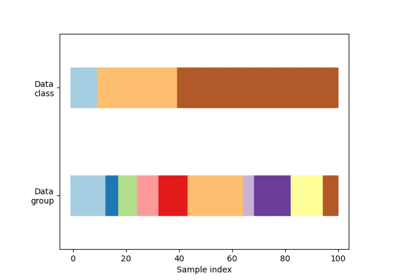sklearn.model_selection.GroupKFold¶
- class sklearn.model_selection.GroupKFold(n_splits=5)[source]¶
K-fold iterator variant with non-overlapping groups.
Each group will appear exactly once in the test set across all folds (the number of distinct groups has to be at least equal to the number of folds).
The folds are approximately balanced in the sense that the number of distinct groups is approximately the same in each fold.
Read more in the User Guide.
- Parameters:
- n_splitsint, default=5
Number of folds. Must be at least 2.
Changed in version 0.22:
n_splitsdefault value changed from 3 to 5.
See also
LeaveOneGroupOutFor splitting the data according to explicit domain-specific stratification of the dataset.
StratifiedKFoldTakes class information into account to avoid building folds with imbalanced class proportions (for binary or multiclass classification tasks).
Notes
Groups appear in an arbitrary order throughout the folds.
Examples
>>> import numpy as np >>> from sklearn.model_selection import GroupKFold >>> X = np.array([[1, 2], [3, 4], [5, 6], [7, 8], [9, 10], [11, 12]]) >>> y = np.array([1, 2, 3, 4, 5, 6]) >>> groups = np.array([0, 0, 2, 2, 3, 3]) >>> group_kfold = GroupKFold(n_splits=2) >>> group_kfold.get_n_splits(X, y, groups) 2 >>> print(group_kfold) GroupKFold(n_splits=2) >>> for i, (train_index, test_index) in enumerate(group_kfold.split(X, y, groups)): ... print(f"Fold {i}:") ... print(f" Train: index={train_index}, group={groups[train_index]}") ... print(f" Test: index={test_index}, group={groups[test_index]}") Fold 0: Train: index=[2 3], group=[2 2] Test: index=[0 1 4 5], group=[0 0 3 3] Fold 1: Train: index=[0 1 4 5], group=[0 0 3 3] Test: index=[2 3], group=[2 2]
Methods
get_n_splits([X, y, groups])Returns the number of splitting iterations in the cross-validator
split(X[, y, groups])Generate indices to split data into training and test set.
- get_n_splits(X=None, y=None, groups=None)[source]¶
Returns the number of splitting iterations in the cross-validator
- Parameters:
- Xobject
Always ignored, exists for compatibility.
- yobject
Always ignored, exists for compatibility.
- groupsobject
Always ignored, exists for compatibility.
- Returns:
- n_splitsint
Returns the number of splitting iterations in the cross-validator.
- split(X, y=None, groups=None)[source]¶
Generate indices to split data into training and test set.
- Parameters:
- Xarray-like of shape (n_samples, n_features)
Training data, where
n_samplesis the number of samples andn_featuresis the number of features.- yarray-like of shape (n_samples,), default=None
The target variable for supervised learning problems.
- groupsarray-like of shape (n_samples,)
Group labels for the samples used while splitting the dataset into train/test set.
- Yields:
- trainndarray
The training set indices for that split.
- testndarray
The testing set indices for that split.
Examples using sklearn.model_selection.GroupKFold¶

Visualizing cross-validation behavior in scikit-learn